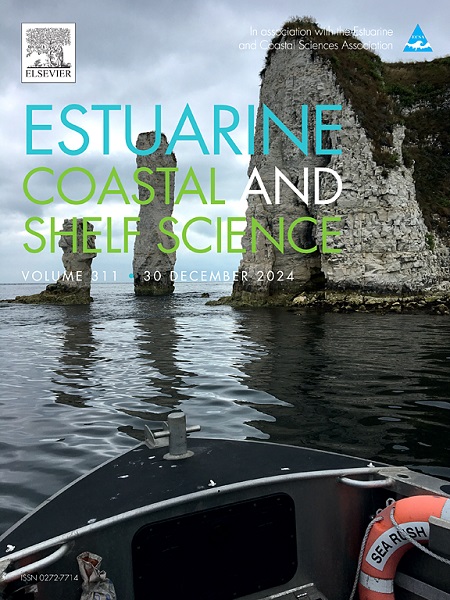沙滩管理对潮间带大型底栖动物的影响:一种通径分析方法
IF 2.6
3区 地球科学
Q1 MARINE & FRESHWATER BIOLOGY
引用次数: 0
摘要
沙滩是由自然过程和人类活动形成的动态沿海生态系统,承载着作为生态健康关键指标的各种大型底栖生物群落。本研究考察了影响意大利艾米利亚罗马涅海岸五个海滩上这些社区的自然和人为驱动因素之间的相互作用。通过通径分析,我们量化了环境变量的直接和间接影响,包括沉积物特征、物理过程、海滩形态和管理实践。在高潮位和低潮位进行采样,分析330个样本,评估群落结构和多样性。结果表明,自然驱动因素和人为驱动因素对大型底栖动物群落均有显著影响,且影响差异较大。积极影响与海滩营养有关,这增加了生境的可用性;而频繁的机械化清理和人工沙丘建设等做法对多样性和丰度产生了负面影响。其他驱动因素,包括侵蚀和沉降,与物种丰富度和群落组成表现出复杂的关系,突出了海滩形态动力学作为底栖生物多样性决定因素的作用。结果表明,多毛藻(polychaete Scolelepis)在营养环境中生长旺盛,而多毛藻(Polydora sp.)对干扰普遍敏感。优势双壳类动物地中海Lentidium mediterranum对管理表现出中性反应,但受到沉积物性质的影响。这些发现强调需要适应性强、生态敏感的海滩管理策略,以平衡旅游需求和保护目标。本研究强调了路径分析在揭示复杂生态相互作用方面的价值,为日益增长的环境和人为压力下的沙滩生态系统可持续管理提供了见解。未来的工作应该将这些发现整合到更广泛的框架中,以解决沿海恢复力和生物多样性保护问题。本文章由计算机程序翻译,如有差异,请以英文原文为准。
Disentangling the effects of sandy beach management on intertidal macrobenthic fauna: A path analysis approach
Sandy beaches are dynamic coastal ecosystems shaped by natural processes and human driven activities, hosting diverse macrobenthic communities that serve as key indicators of ecological health. This study examines the interplay between natural and anthropogenic drivers affecting these communities across five beaches along the Emilia Romagna coast, Italy. By employing path analysis, we quantified the direct and indirect effects of environmental variables, including sediment characteristics, physical processes, beach morphology, and management practices. Sampling was conducted at high and low tidal levels, analyzing 330 samples to assess community structure and diversity. Results reveal that both natural and human drivers significantly influence macrobenthic communities, with contrasting effects. Positive impacts were associated with beach nourishment, which increased habitat availability; while practices such as frequent mechanized cleaning and artificial dune construction negatively impacted diversity and abundance. Other drivers, including erosion and subsidence, exhibited complex relationships with species richness and community composition, highlighting the role of beach morphodynamics as a determinant of benthic diversity. Species-specific responses were observed, with the polychaete Scolelepis (scolelepis) squamata thriving in nourished environments, while Polydora sp. generally showed sensitivity to disturbance. The dominant bivalve Lentidium mediterraneum displayed neutral responses to management but was influenced by sediment properties. These findings emphasize the need for adaptive, ecologically sensitive beach management strategies that balance tourism demands with conservation goals. This study highlights the value of path analysis in unraveling complex ecological interactions, offering insights for the sustainable management of sandy beach ecosystems under increasing environmental and anthropogenic pressures. Future efforts should integrate these findings into broader frameworks addressing coastal resilience and biodiversity conservation.
求助全文
通过发布文献求助,成功后即可免费获取论文全文。
去求助
来源期刊
CiteScore
5.60
自引率
7.10%
发文量
374
审稿时长
9 months
期刊介绍:
Estuarine, Coastal and Shelf Science is an international multidisciplinary journal devoted to the analysis of saline water phenomena ranging from the outer edge of the continental shelf to the upper limits of the tidal zone. The journal provides a unique forum, unifying the multidisciplinary approaches to the study of the oceanography of estuaries, coastal zones, and continental shelf seas. It features original research papers, review papers and short communications treating such disciplines as zoology, botany, geology, sedimentology, physical oceanography.

 求助内容:
求助内容: 应助结果提醒方式:
应助结果提醒方式:


